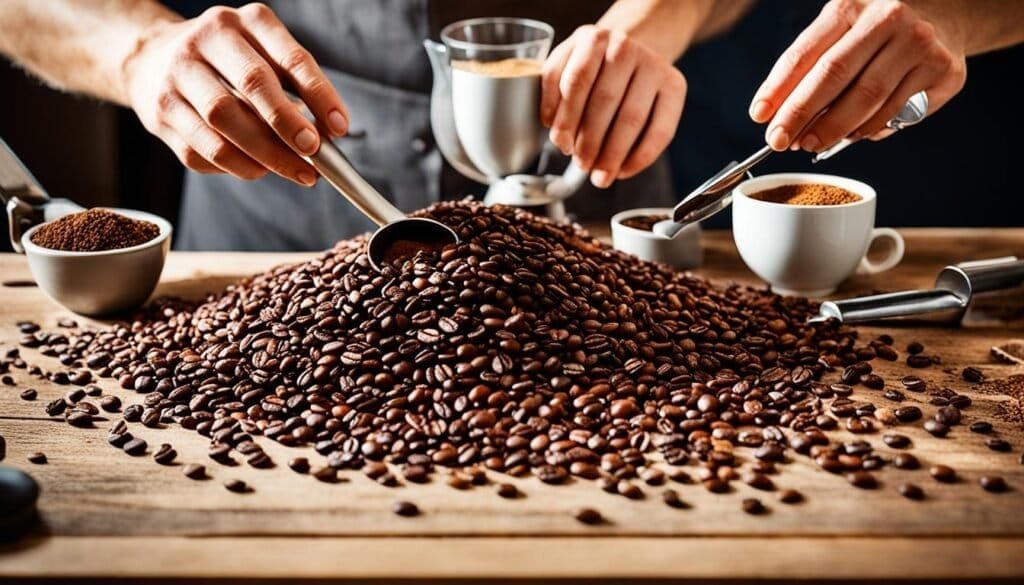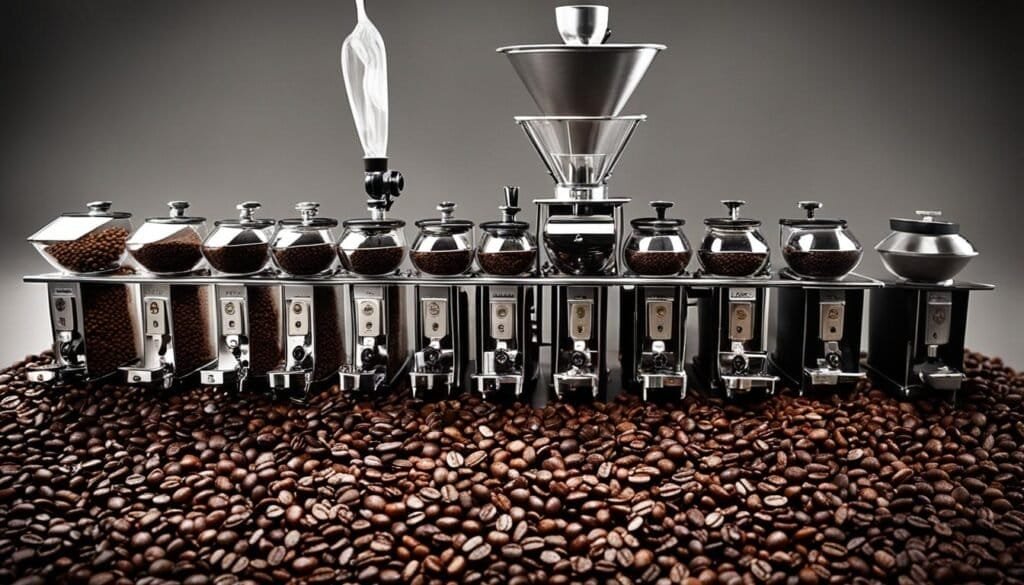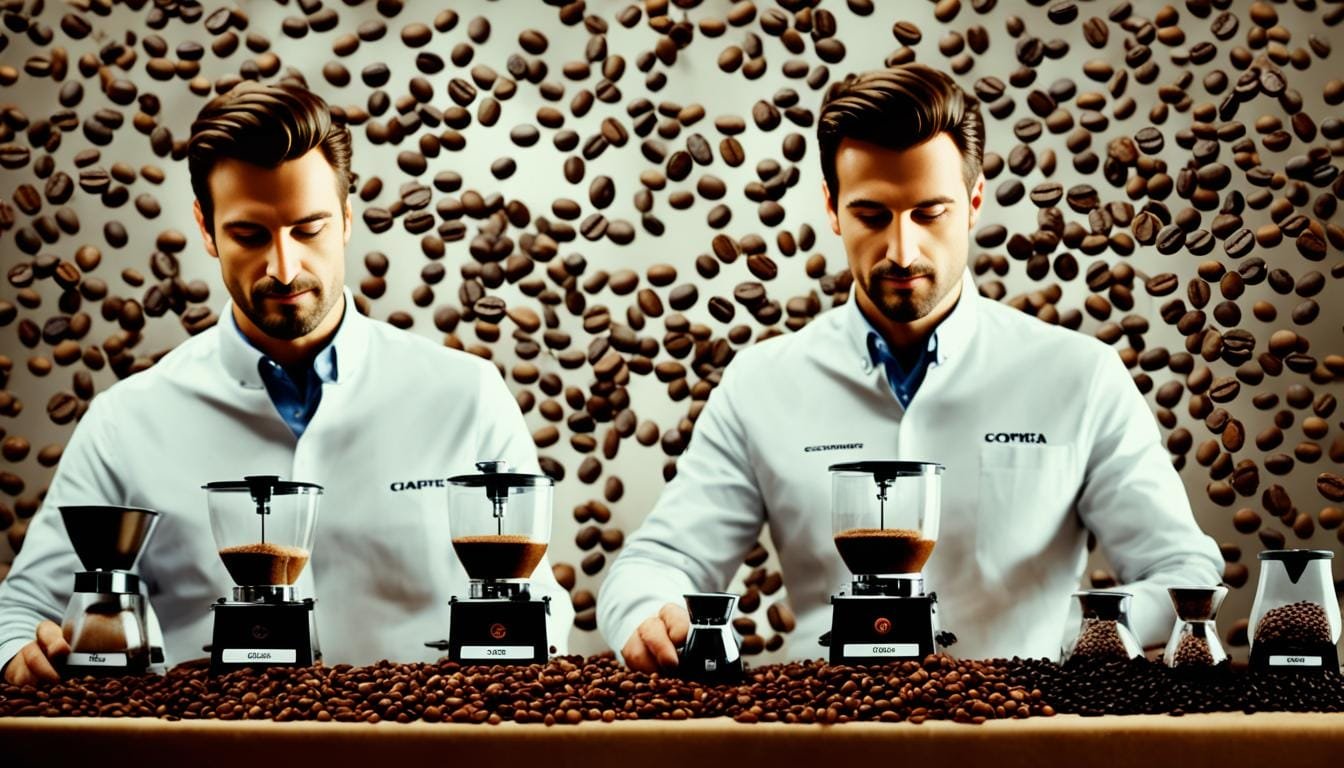Did you know that professional coffee blending involves combining different coffee beans in specific ratios to create unique flavor profiles? With advanced coffee blending techniques, roasters can craft specialty coffee blends that cater to the diverse preferences of coffee enthusiasts.
When it comes to coffee roasting and blending, precise control over roasting temperatures and blending methods is essential. The roasting temperature typically ranges between 200°C and 250°C (392°F and 482°F), but can vary based on factors such as bean origin and desired roast level. By mastering the art of advanced coffee blending, you can unlock a world of complex flavors and create your own signature coffee blend.
Key Takeaways:
- Advanced coffee blending involves combining different coffee beans in specific ratios to create unique flavor profiles.
- Precise control over roasting temperatures and blending methods is essential for mastering advanced coffee blending.
- By understanding the art of advanced coffee blending, you can create your own signature coffee blend that caters to your preferences.
- Experimenting with different coffee blending techniques can unlock a world of complex flavors and elevate your coffee experience.
- Joining coffee blending communities and accessing expert tips and resources can provide valuable insights and enhance your blending skills.
The Essence of Coffee Blending
In the world of coffee, blending is an art form that allows roasters to create unique flavor profiles by combining different roasted beans. This process enhances the complexity of coffee, resulting in a cup that offers a spectrum of flavors to delight your taste buds.
One of the key advantages of coffee blending is its ability to ensure consistency in flavor and quality year-round. By adjusting the blend components based on seasonal changes, roasters can maintain a consistent taste experience for their customers. This consistency fosters loyalty and creates a sense of familiarity, making your coffee a reliable companion in every cup.
Another benefit of coffee blending is its cost-management aspect. By combining more affordable beans with premium ones, roasters can achieve a balanced and delicious cup without compromising on flavor. This approach allows coffee enthusiasts to indulge in high-quality blends while optimizing their cost management strategies.
The Complexity of Flavors in Coffee Blending
Blending different beans creates a synergy of flavors, resulting in a cup of coffee that is greater than the sum of its parts. By combining beans with different tasting notes, such as fruity, nutty, or chocolatey, you can achieve a harmonious balance of flavors that tantalize the palate and add depth to your coffee experience.
“Coffee blending is a creative endeavor that allows roasters to unlock the true potential of each bean, bringing out the best characteristics and enhancing flavor complexity in every cup.”
The Role of Consistency in Coffee Blending
Consistency is a hallmark of excellence in the coffee industry, and coffee blending plays a crucial role in achieving this. By meticulously selecting and blending beans, roasters can maintain the same flavor profile and quality standards throughout the year. This not only ensures customer satisfaction but also establishes your brand as a trusted source of consistent and exceptional coffee.
Cost Management through Coffee Blending
Blending more affordable beans with premium ones presents an opportunity for cost management in the coffee industry. By combining beans of different price ranges, you can craft blends that offer exceptional taste and value, allowing you to attract a wider audience without compromising on the quality of your coffee.
To illustrate the cost-management aspect of coffee blending, consider the following comparison:
| Scenario | Result |
|---|---|
| Using solely premium beans | Higher production costs and retail prices |
| Blending premium beans with more affordable beans | Lower production costs with maintained taste quality and affordable retail prices |
This example demonstrates how coffee blending enables roasters to strike a balance between taste excellence and cost efficiency, making your coffee accessible to a broader consumer base.
By embracing the art of coffee blending, you can unlock endless possibilities to create unique flavor profiles, ensure consistency, and manage costs. So, why not embark on this journey of discovery and take your coffee blending skills to new heights?
Getting Started with Coffee Blending
When embarking on the journey of mastering advanced coffee blending, it is crucial to begin with selecting the right beans. The selection process involves considering factors such as the beans’ origin, roast levels, and varietals, as these elements significantly contribute to the overall flavor profile of the blend.
Once you have chosen the desired beans, the next step is determining the blend components. This involves carefully selecting the specific beans that will be combined to create a harmonious blend. Each bean brings its unique characteristics, such as tasting notes and aromas, adding layers of complexity to the final cup.
Blending ratios play a vital role in achieving the desired flavor outcome. The proportions of each blend component need to be carefully measured and adjusted to strike the perfect balance that showcases the desired flavor profiles. Experimentation and a keen sense of taste are essential in finding the optimal blending ratios that suit your preferences.
There are various blending methods to explore when crafting a coffee blend. Some popular methods include:
- Classic Blend: This method combines different bean varieties and roast levels to create a well-rounded and balanced cup.
- Accent Blend: Accent blends showcase a dominant flavor profile by adding a smaller portion of an intensely flavored bean to compliment the main blend.
- Layered Blend: Layered blends involve creating distinct layers of different beans in the brewing process, resulting in a cup that offers diverse flavor experiences throughout.
- Single-Origin Blend: Single-origin blends focus on featuring the unique flavors of a specific bean origin, highlighting the terroir and characteristics of the region.
By experimenting with these blending methods, you can unlock a world of flavor possibilities and create blends that cater to your taste preferences.
Example Blending Method Comparison
| Blending Method | Description | Advantages |
|---|---|---|
| Classic Blend | A combination of different bean varieties and roast levels to create balance and complexity. | Offers a well-rounded cup, showcasing the characteristics of different beans. |
| Accent Blend | Adds a smaller portion of an intensely flavored bean to complement the main blend and emphasize specific flavors. | Allows for the creation of unique, emphasized flavor profiles. |
| Layered Blend | Creates distinct layers of different beans in the brewing process, offering diverse flavor experiences throughout. | Delivers complexity and an evolving flavor profile to keep your taste buds intrigued. |
| Single-Origin Blend | Focuses on featuring the unique flavors of a specific bean origin, highlighting the terroir and characteristics of the region. | Allows coffee lovers to appreciate the distinct flavors of specific coffee-growing regions. |
Experimenting with these blending methods will enable you to craft unique flavor profiles that stand out and satisfy the palates of coffee connoisseurs.

Blending and Roasting Process
Once the blend components have been selected, it’s time to start the blending and roasting process. This crucial step in mastering advanced coffee blending involves precise measurements, separate roasting, careful cooling and resting, and meticulous tasting and evaluation.
Measuring Beans
Accurate measuring of beans is essential to maintain the desired ratios for your blend. Use a digital scale to weigh the beans precisely according to the recipe or desired flavor profile. This ensures consistency and allows you to replicate exceptional blends consistently.
Roasting Separately
After measuring the beans, it’s time to roast them separately. Each bean may require different roasting levels to bring out its unique characteristics. By roasting separately, you have better control over the roast profile of each bean, allowing you to achieve the desired flavor complexity and balance.
Cooling and Resting
Once the beans have reached their ideal roast levels, it’s important to cool them down quickly to prevent overcooking. Proper cooling helps to preserve the flavors and aromas of the beans. After cooling, the beans need to rest for a certain period to stabilize and develop their flavors. This resting period allows the beans to degas and mellow, resulting in a smoother and more harmonious cup of coffee.
Tasting and Evaluating
Tasting and evaluating your blend is the final step in the blending and roasting process. Engage in cupping, a professional coffee tasting technique, to assess the flavors, aroma, body, acidity, and overall impression of your blend. Take detailed notes to document your observations and make necessary adjustments to refine and perfect your blend.

Quick Reference Guide: The Blending and Roasting Process
| Step | Description |
|---|---|
| Measuring Beans | Weigh the beans accurately according to the desired blend ratios. |
| Roasting Separately | Roast each bean separately to achieve the optimal roast level for its flavor profile. |
| Cooling and Resting | Cool the beans quickly and allow them to rest to stabilize and enhance their flavors. |
| Tasting and Evaluating | Engage in cupping to taste and evaluate the flavors, aroma, and overall impression of your blend. |
By mastering the blending and roasting process, you can unlock the full potential of your coffee beans and create exceptional blends. The attention to detail and dedication to quality will result in a memorable coffee experience for you and your customers.
Conclusion
Mastering advanced coffee blending is a thrilling journey that allows you to explore your creativity and create unique flavor profiles that truly reflect your personal taste and preferences. By carefully selecting the right beans, experimenting with blending ratios and methods, and honing your roasting process, you can unlock endless possibilities for crafting exceptional coffee blends.
To enhance your skills and expand your knowledge, consider joining coffee blending communities where you can connect with like-minded enthusiasts, share experiences, and learn from experts in the field. These communities provide valuable resources and deeper insights into the intricate art of coffee blending, helping you take your skills to the next level.
Embrace the world of coffee blending and let your imagination run wild. Experiment with different combinations, explore the nuances of flavor, and discover your very own signature coffee blend. With dedication, passion, and the right resources, you can elevate your coffee experience to new heights and delight your senses with each and every sip of your meticulously crafted creation.
FAQ
What is coffee blending?
Coffee blending is the art of combining different roasted beans to create unique flavor profiles.
Why is coffee blending important?
Coffee blending enhances complexity, ensures consistency in flavor and quality, and can be a cost-effective way to improve the flavor of more affordable beans.
How do I get started with coffee blending?
To get started, select the right beans based on their origin, roast levels, and varietals, and choose a blending method that suits your desired flavor outcome.
What does the blending and roasting process entail?
The blending and roasting process involves measuring the beans precisely, roasting them separately to their ideal roast levels, allowing them to cool and rest, and evaluating the flavors through cupping techniques.
How can I master advanced coffee blending?
To master advanced coffee blending, experiment with different combinations of beans, blending ratios, and methods, and connect with coffee blending communities and resources to gain deeper insights and share experiences.
Source Links
- https://www.homeroastingsupplies.com/blogs/news/mastering-the-art-of-coffee-roasting-a-comprehensive-guide
- https://www.homeroastingsupplies.com/blogs/news/coffee-blending-crafting-unique-flavor-profiles-through-the-art-of-bean-fusion
- https://kitchenhousecoffee.com/best-techniques-for-roasting-coffee-beans/




